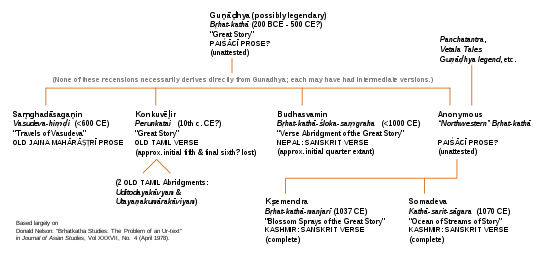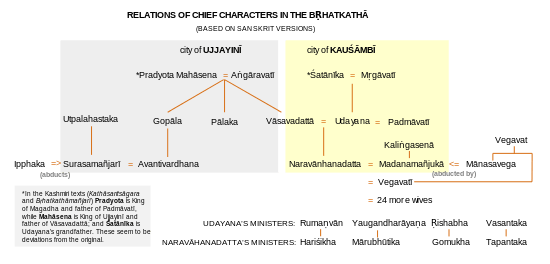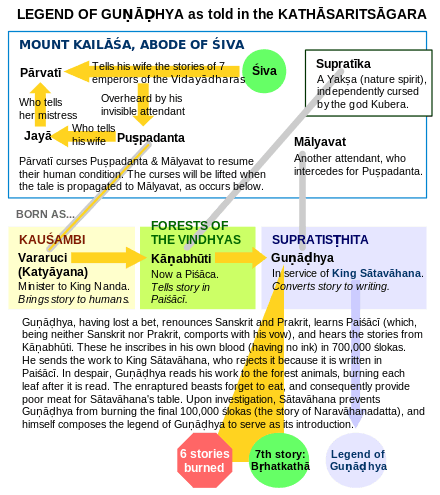Brihatkatha
Bṛhatkathā (Sanskrit, "the Great Narrative") is an ancient Indian epic, said to have been written by Guṇāḍhya in a poorly-understood language known as Paiśācī. The work no longer exists but several later adaptations — the Kathāsaritsāgara (कथासरित्सागर), Bṛhatkathāmañjarī (बृहत्कथामंजरी) and Bṛhatkathāślokasaṃgraha (बृहत्कथाश्लोकसंग्रह) in Sanskrit, as well as the Peruṅkatai and Vasudevahiṃḍi in vernaculars — make commentary on the piece.
| by Guṇāḍhya | |
 Probable relationship between versions of the Brihatkatha | |
| Language | Paisaci |
|---|---|
| Form | epic |
The date of its composition is uncertain. According to testimonials by later Sanskrit poets such as Daṇḍin, Subandhu, and Bāṇa, the Bṛhatkathā existed in the 6th century AD.[1] According to other estimates it predates that period by several more centuries. For example, if the story of Udayana by poet Bhāsa (and also later by Harsha in Ratnavali) was inspired by Brihatkatha, it had to be older than the time of Bhāsa — itself uncertain, but before the 3rd century AD.
Early references
The earliest extant reference to the Bṛhatkathā seems to be that of Subandhu (600-700 AD) in Vasavadatta.[2] Bāṇa (7th century) refers to it in his romances Harshacharita and Kadambari.[3] A reference by Daṇḍin in his Kavyadarsha is problematic because it describes the Bṛhatkathā as being marvelous and as composed in the vernacular of the bhūtas (evidently Paiśācī). However, the information appears to be second-hand. A fuller reference is provided in Dashakumaracharita, whose author is possibly not the same Daṇḍin.[4] Later references include the Daśarūpa of Dhanamjaya, Nalacampū of Trivikramabhaṭṭa,[5] and Āryāsaptaśatī of Govardhanācārya.[6] A Cambodian inscription (c. 875) expressly mentions Guṇāḍhya and his aversion to Prakrit.[7] The earliest extant Kannada work on grammar and poetics, Kavirajamarga by Nripatunga (c. 850), mentions a now-lost Sanskrit version of Bṛhatkathā by the author Durvinita. We can safely assume the existence of a romantic work by Guṇāḍhya before AD 600.
Reconstructed content

Although several derivative works remain today, they differ so greatly that they cannot be used to reconstruct the Bṛhatkathā in its totality. However, some strong inferences can be made about its content based on their similarities.[8]
Udayana
Due to a dohada ("pregnancy craving"), Mṛgāvatī, pregnant with Udayana, is either covered or immersed in red. A monstrous bird mistakes her for raw meat and carries her away, later dropping her. She is cared for in a hermitage, where she raises her son.[9] Udayana obtains a wonderful lute, elephant-taming skills, and confidants; he and his mother eventually return to their home, Kauśāmbī.[10]
Udayana is later captured by Pradyota, the King of Ujjayinī. Here, he teaches the lute to Pradyota's daughter, Vāsavadattā, and they fall in love.[11] Eventually, they escape to Kauśāmbī, where Udayana's rightful kingship is restored, and they are married.[12] But, fearing Udayana is weakening, and desiring an additional political alliance, Udayana's ministers make him believe that Vāsavadattā is dead, and arrange a marriage to Padmāvatī.[13]
Though he is later reunited with Vāsavadattā, Udayana remains childless. Later, as a boon of Kubera, Vāsavadattā becomes pregnant with Naravāhanadatta (his name means "given by Kubera"),[14] who is fated to become the emperor of the Vidyādharas.
Naravānhanadatta
Udayana's life serves as the prelude to the central story of his son, Naravānhanadatta. Unlike his father, who appears in several works unrelated to the Bṛhatkathā, Naravānhanadatta is known only from texts demonstrably linked to the Bṛhatkathā.[15]
| Sanskrit | Tamil (Peruṅkatai) |
|---|---|
| Kauśāmbī | Kōcampi |
| Ujjayinī | Uñcai, Uñcēṉai |
| Gomukha | Kōmukaṉ |
| Hariśikha | Arucikaṉ |
| Kaliṅgasenā | Kaliṅkacēṉai |
| Madanamañjukā | Mataṉamañcikai |
| Mānasavega | Māṇacavēkaṇ |
| Mārubhūtika (Bhūti, Marubhūti) | Pūti |
| Naravānhanadatta | Naravāṇatattaṉ |
| Padmāvatī | Patumāpati |
| Pradyota Mahāsena | Piraccōtaṉaṉ Maṟamāccēṉaṉ |
| Ṛṣabhaka | Iṭapakaṉ |
| Rumaṇvān (Rumaṇvat) | Urumaṇṇuvā |
| Śatānīka | Catāṉikaṉ |
| Tapantaka | Tavantakaṉ |
| Udayana | Utayaṇaṉ |
| Vasantaka | Vayantakaṉ |
| Vāsavadattā | Vācavatattai |
| Vegavatī | Vēkavati |
| Yaugandharāyaṇa | Yūkantarāyaṇaṉ, Yūki |
| Placenames in gray. | |
| Sanskrit | Mahārāṣṭri |
|---|---|
| Naravānhanadatta | Vasudeva[17] |
| Udayana | Aṃdhagavaṇhi[18] |
Legendary origin

For the origin of Brihatkatha as described in Kathasaritsagara, see the adjacent diagram.[20]
Notes
- Winternitz 1985, p 346.
- Vijayalakshmy 1981, p 11.
- Nelson 1974, pp 19-22.
- Nelson 1974, pp 33-35.
- Vijayalakshmy 1981, pp 11-12.
- Nelson 1974, pp 36-37.
- Vijayalakshmy 1981, pp 12-13.
- Reconstruction based on Nelson 1974, pp 324-327 & Nelson 1978, pp 665-669; except where noted.
- Vijayalakshmy 1981, pp 58-60.
- Vijayalakshmy 1981, pp 60-62.
- Vijayalakshmy 1981, pp 60-62.
- Vijayalakshmy 1981, pp 78-81.
- Vijayalakshmy 1981, pp 84-86.
- Penzer 1924, Vol IX p 119.
- Nelson 1974, pp 16-17.
- Nelson 1974, pp 330-332.
- Nelson 1974, p 197.
- Nelson 1974, p 206.
- Lacôte 1923, pp 22-25.
- "Gunadhya" from "The Encyclopaedia Of Indian Literature (Volume Two) (Devraj to Jyoti)" by Amaresh Datta, page 1506.
References
- Lacôte, Felix; Tabard, A. M. (translator) (1923). Essay on Gunādhya and the Brhatkathā. Bangalore City: Bangalore Press.CS1 maint: ref=harv (link) (reprint, from the Quarterly Journal of the Mythic Society, of Tabard's translation of Lacôte 1908: Essai sur Guṇāḍhya et la Bṛhatkathā at the Internet Archive)
- Nelson, Donald (1974). The Bṛhatkathā: A Reconstruction from Bṛhatkathāślokasaṃgraha, Peruṅkatai and Vasudevahiṃḍi. University of Chicago.CS1 maint: ref=harv (link) (PhD Dissertation)
- Nelson, Donald (August 1978). "Bṛhatkathā Studies: The Problem of an Ur-text". Journal of Asian Studies. Association for Asian Studies. XXXVII (4): 663–676. JSTOR 2054369.
- Penzer, N. M. (1924). The Ocean of Story, being C.H. Tawney's Translation of Somadeva's Kathā Sarit Sāgara (or Ocean of Streams of Story). London: Chas. J. Sawyer.CS1 maint: ref=harv (link) Vol I, Vol II, Vol III, Vol IV, Vol V, Vol VI, Vol VII, Vol VIII, Vol IX, Vol X at the Internet Archive, or as proofread HTML eBook Volume 1-9, including thousands of notes and large appendixes.
- Vijayalakshmy, R. (1981). A Study of the Peruṅkatai: an authentic version of the story of Udayana. Madras: International Institute of Tamil Studies.
- Winternitz, Moriz (1 January 1985). History of Indian Literature. Motilal Banarsidass. ISBN 978-81-208-0056-4.CS1 maint: ref=harv (link)